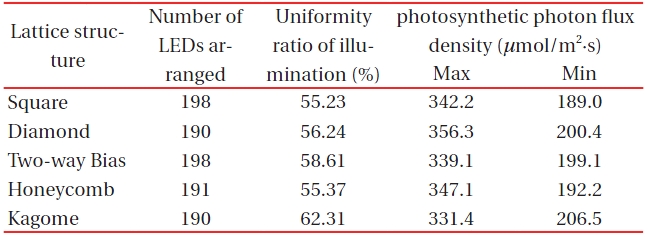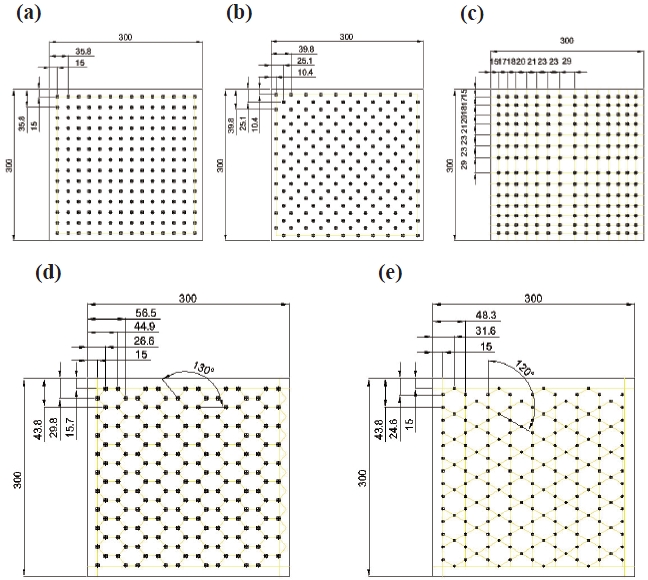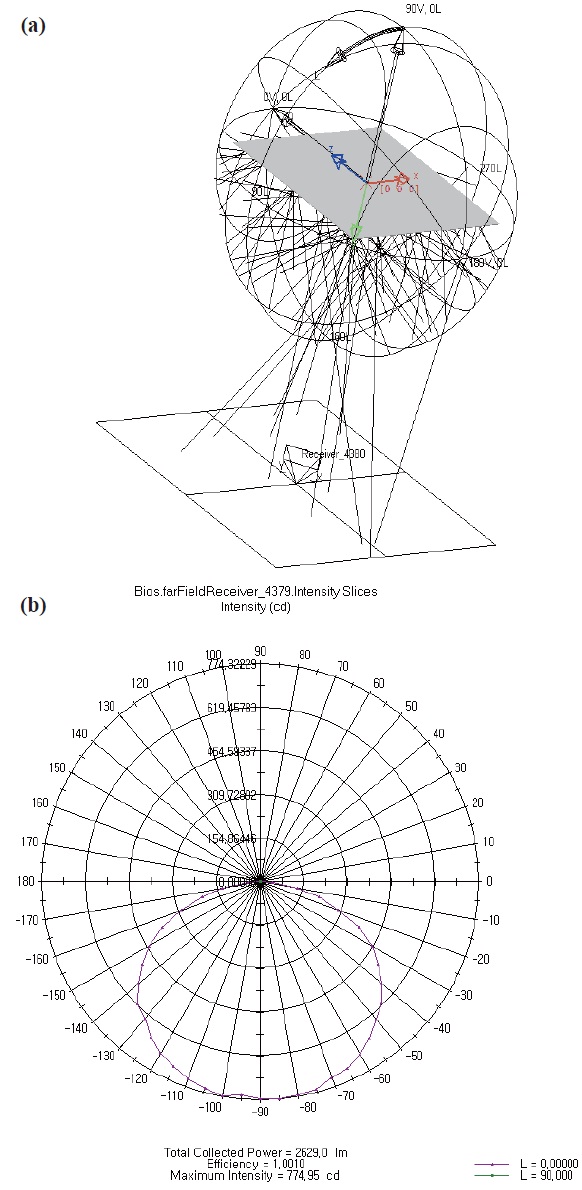



Light-emitting diodes (LEDs) are being widely used in the fields of LED TVs, mobile phones, lighting sources for medical instruments, illumination systems and traffic signals, due to their advantages such as low power consumption, long lifetime, high luminance, rapid response time, good mechanical properties and environmental friendliness. Recently in the lighting community, several approaches for luminous quantity, illuminance, electric current and photosynthetic photon flux density (PPFD) characteristics and for optimal design of LED packages have been performed [1-3]. LEDs have high luminance and wide spans of dominant wavelengths within the entire visible spectrum. Because of the narrow spectral distribution, LEDs are being further evaluated as one of the possible standard light source [4-7]. LED arrays are everywhere. They can be found in many shapes and sizes. They also cover a wide range of applications [2-3]. The LED arrays in applications and the performances of the LED lighting systems are intimately associated with three design principles such as high luminance or illuminance, heat dissipation and low power consumption. Particularly, the high uniformity ratio of illuminance was affected closely by the arrangement of the LED light sources (e.g., phototherapy, plant growth, microbiological incubation, and road lamp, etc.).
In this work, the uniformity ratio of illuminance and PPFD of the periodic 2D lattice arrangements were investigated. Namely, the effect of different arrays, such as square, diamond, two-way bias quadrangular, hexagonal honeycomb, and Kagome lattices, were optically simulated under the same transmissivity, absorptance and reflectivity.
2.1 LEDs array with different two-dimensional lattices
With the advancement of high-speed computing and optical analysis software packages, LightTools version 7.0, the computer-aided optical analyses of LED, LCD light guide plates, optical film and optical lens can be accelerated, in order to save time, manpower and costs [4-7]. Five arrays were designed for a LED in order to study the radiation pattern, uniformity ratio of illuminance and PPFD without lens. In a plate type LED lighting device, a unit-cell is repeated in a two-dimensional space to construct a bulk array. Fig. 1 shows the configurations of five different arrays, i.e., square, diamond, two-way bias quadrangular, hexagonal, and Kagome lattices, in the form of a plate type LED. This has its applications in both indoor and outdoor lighting fixtures, and also in the improvement of phototherapy, plant growth, and microbiological incubation.
Specifically, a Kagome lattice is an arrangement of hexagonal lattices. They are composed of triangles such that each point where two hexagonal lattices cross has four neighboring points. Although it is called as a lattice, it is more closely related to the tri-hexagonal tiling than to a mathematical lattice. Some minerals, namely jarosites and herbertsmithite, contain layers of Kagome lattice arrangement of atoms in their crystal structure.
3.1 LED radiation pattern by different arrays
LRG6SP RED 620 to 629 nm, available from OSRAM, was used as LEDs. The LEDs having the same size (300 mm × 300 mm) were arranged on boards (PCBs) in a manner as shown in the figures. The distances between a measuring apparatus (receiver) that measures the uniformity ratio of illumination and the lighting systems were set to be 450 mm. The uniformity ratio of illumination of the respective lighting systems were measured at
[Table 1.] Optical simulation results of five different arrays and number of LEDs.

Optical simulation results of five different arrays and number of LEDs.
measuring areas of 450 mm × 450 mm. Table 1 reports the number of LEDs of the respective lighting systems and the results obtained by measuring the uniformity ratio of illumination and PPFD of the respective lighting systems.
Figure 2 shows the LED radiation pattern of square, diamond, two-way bias quadrangular, hexagonal, and Kagome lattice lighting without the lens, respectively. The differences in the LED radiation pattern of all lattices without the lens were almost not distinguishable, i.e., Lambertian type LED [8]. The result was attributed to the concentration and the diffusion of the lens in the LED light. To be specific, the design parameters of the LED radiation pattern was lens bottom width, lens height, diameter of diffusion mechanism, radius of lens negative camber, radius of lens positive camber and the radius of the curved surface of the diffusion mechanism.
3.2 Uniformity ratio of illuminance and PPFD by different arrays
Table 1 reports the results obtained by measuring the uniformity distributions of the LED lighting systems. Referring to Table 1, it can be appreciated that the lighting system having a structure for arranging light sources using a Kagome lattice of the present simulation exhibited the highest uniformity distribution of 62.3%. This is improved by over 7% than the lighting system which has a structure for arranging the light sources using a quadrangular lattice. Moreover, the PPFD of the Kagome lattice of the present simulation was absolutely superior compared to its competitors, whereas the LEDs’ number of Kagome was smaller than that of all the others. The result was attributed to the fact that a strong dynamic spin fluctuation, buckling resistance, heat transfer, and electrical conductivity of the Kagome lattice systems were higher than that of the competitors [9,10].
Uniformity ratio of illuminance and photosynthetic photon flux density of the periodic 2D lattice arrangements were explored by using an illumination simulation analysis. In this preliminary work, two-dimensional square, diamond, two-way bias quadrangular, hexagonal honeycomb, and Kagome lattices were considered for applications of the LED lighting systems. The result particularly showed that the uniformity ratio of illumination and the PPFD of a two-dimensional Kagome lattice outperformed the other lattices for a given transmissivity, absorptance and reflectivity. In future, illumination performances of the Kagome lattices with component connections can be studied for realistic applications such as lighting systems of large-scale roofs and the physiological responses or the characteristics of improved plant growth, nutritive elements and microbiological incubation.


